
Stewarton
Encyclopedia
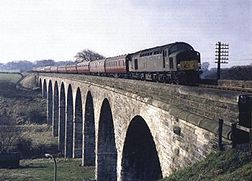
East Ayrshire
East Ayrshire is one of 32 council areas of Scotland. It borders on to North Ayrshire, East Renfrewshire, South Lanarkshire, South Ayrshire and Dumfries and Galloway...
, Scotland
Scotland
Scotland is a country that is part of the United Kingdom. Occupying the northern third of the island of Great Britain, it shares a border with England to the south and is bounded by the North Sea to the east, the Atlantic Ocean to the north and west, and the North Channel and Irish Sea to the...
. In comparison to the neighbouring towns of Kilmaurs
Kilmaurs
Kilmaurs is a village in East Ayrshire, Scotland. It lies on the Carmel, 21.1 miles south by west of Glasgow. Population recorded in 2001 Census, 2601- History :...
, Fenwick
Fenwick, East Ayrshire
Fenwick is a village in East Ayrshire, Scotland, UK. As of 2001, its population was 863.Fenwick is the terminus of the M77 following its extension which was opened in April 2005, at the beginning of the Kilmarnock bypass....
, Dunlop
Dunlop, East Ayrshire
Dunlop is a village and parish in East Ayrshire, Scotland. It lies on the A735, north-east of Stewarton, seven miles from Kilmarnock. The road runs on to Lugton and the B706 enters the village from Beith.-The village:...
and Lugton
Lugton
Lugton is a small village or hamlet in East Ayrshire, Scotland with a population of 80 people. The A736 road runs through on its way from Glasgow, to the north, to Irvine in North Ayrshire. Uplawmoor is the first settlement on this 'Lochlibo Road' to the north and Burnhouse is to the south...
, it is a relatively large town, with a population of over 6,500.Scotland's Census Results OnLine 2001 It is 300 feet above sea level.Groome, Francis H. (1903). Ordnance Gazetteer of Scotland. Pub. Caxton. London. P. 1506. The town is served by Stewarton railway station
Stewarton railway station
Stewarton railway station is a railway station in the town of Stewarton, East Ayrshire, Scotland. The station is managed by First ScotRail and is on the Glasgow South Western Line.- History :...
.
Stewarton is on the Annick Water in a rural part of northern Ayrshire, about 6 miles to the North of Kilmarnock
Kilmarnock
Kilmarnock is a large burgh in East Ayrshire, Scotland, with a population of 44,734. It is the second largest town in Ayrshire. The River Irvine runs through its eastern section, and the Kilmarnock Water passes through it, giving rise to the name 'Bank Street'...
and to the East of Irvine. In the past, Stewarton served as a crossroads between the traditional routes from Kilmarnock, Irvine and Ayr
Ayr
Ayr is a town and port situated on the Firth of Clyde in south-west Scotland. With a population of around 46,000, Ayr is the largest settlement in Ayrshire, of which it is the county town, and has held royal burgh status since 1205...
to the city of Glasgow
Glasgow
Glasgow is the largest city in Scotland and third most populous in the United Kingdom. The city is situated on the River Clyde in the country's west central lowlands...
, though in recent times the M77 motorway
M77 motorway
The M77 motorway is a motorway in Scotland. It originally began in southern Glasgow at the M8 motorway at Kinning park, and terminates near Kilmarnock at the village of Fenwick. However, changes were made in autumn 2005 segregating a lane on the M8 motorway almost as far as the Kingston Bridge,...
has bypassed the town. The old road is known as the "auld Glesga road" and is still used by Stewartonians.
King Malcolm Canmore and Friskin
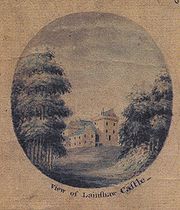
William Shakespeare
William Shakespeare was an English poet and playwright, widely regarded as the greatest writer in the English language and the world's pre-eminent dramatist. He is often called England's national poet and the "Bard of Avon"...
's play Macbeth
Macbeth
The Tragedy of Macbeth is a play by William Shakespeare about a regicide and its aftermath. It is Shakespeare's shortest tragedy and is believed to have been written sometime between 1603 and 1607...
. As the legend goes, Mac Bethad
Macbeth of Scotland
Mac Bethad mac Findlaích was King of the Scots from 1040 until his death...
had slain Donnchad to enable himself to become king of Scotland and immediately turned his attention towards Donnchad's son Máel Coluim (the next in line to the throne). When Máel Coluim learned of his father's death and Mac Bethad's intentions to murder him, he fled for the relative safety of England
England
England is a country that is part of the United Kingdom. It shares land borders with Scotland to the north and Wales to the west; the Irish Sea is to the north west, the Celtic Sea to the south west, with the North Sea to the east and the English Channel to the south separating it from continental...
. Unfortunately for Máel Coluim, Mac Bethad and his associates had tracked him down and were gaining on him as he entered the estate of Corsehill on the edge of Stewarton. In panic Máel Coluim pleaded for the assistance of a nearby farmer named either Friskine or Máel Coluim (accounts differ) who was forking hay on the estate. Friskine/Máel Coluim covered Máel Coluim in hay, allowing him to escape Mac Bethad and his associates. He later found refuge with King Harthacanute
Harthacanute
Harthacnut was King of Denmark from 1035 to 1042 and King of England from 1040 to 1042.He was the son of King Cnut the Great, who ruled Denmark, Norway, and England, and Emma of Normandy. When Cnut died in 1035, Harthacnut struggled to retain his father's possessions...
, who reigned as Canute II, King of England and Norway and in 1057, after returning to Scotland and defeating Mac Bethad in the Battle of Lumphanan in 1057 to become King of Scots, he rewarded Friskine's family with the Baillie of Cunninghame to show his gratitude to the farmer who had saved his life 17 years earlier. The Cunninghame family logo now features a "Y" shaped fork with the words "over fork over" underneath - a logo which appears in various places in Stewarton, notably as the logo of the two primary schools in the area - Lainshaw primary school and Nether Robertland primary school.
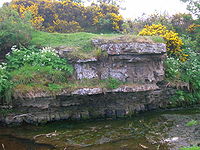
Hugh de Morville, Lord of Cunningham and Lauderdale
Hugh de Morville was a Norman knight who made his fortune in the service of David fitz Malcolm, Prince of the Cumbrians and King of Scots .His parentage is said by some to be unclear, but G. W. S...
, the builder of Kilwinning Abbey
Kilwinning Abbey
Kilwinning Abbey is a ruined abbey located in the centre of the town of Kilwinning, North Ayrshire.-The establishment of the Abbey:The ancient name of the town is 'Segdoune' or 'Saigtown', probably derived from 'Sanctoun', meaning the 'town of the saint'. Saint Winnings festival was on 21 January...
who lived at this time in Tour near Kirkland in Kilmaurs. The family were originally from Morville
Morville
- Belgium :* Morville, Belgium, a part of Florennes in the province of Namur- France :* Morville, Manche, in the Manche département* Morville, Vosges, in the Vosges département* Morville-en-Beauce, in the Loiret département...
in Normandy
Normandy
Normandy is a geographical region corresponding to the former Duchy of Normandy. It is in France.The continental territory covers 30,627 km² and forms the preponderant part of Normandy and roughly 5% of the territory of France. It is divided for administrative purposes into two régions:...
(Wernebald was from Flanders
Flanders
Flanders is the community of the Flemings but also one of the institutions in Belgium, and a geographical region located in parts of present-day Belgium, France and the Netherlands. "Flanders" can also refer to the northern part of Belgium that contains Brussels, Bruges, Ghent and Antwerp...
) and had been established in Scotland for at least twenty years when one of the family was involved in the murder of Thomas Becket
Thomas Becket
Thomas Becket was Archbishop of Canterbury from 1162 until his murder in 1170. He is venerated as a saint and martyr by both the Roman Catholic Church and the Anglican Communion...
. Dervorguilla of Galloway
Dervorguilla of Galloway
Dervorguilla of Galloway was a 'lady of substance' during the 13th century, wife from 1223 of John, 5th Baron de Balliol, and mother of the future king John I of Scotland. The name Dervorguilla or Devorgilla was a Latinization of the Gaelic Dearbhfhorghaill...
, mother of John Balliol
John of Scotland
John Balliol , known to the Scots as Toom Tabard , was King of Scots from 1292 to 1296.-Early life:Little of John's early life is known. He was born between 1248 and 1250 at an unknown location, possibilities include Galloway, Picardy and Barnard Castle, County Durham...
, was a daughter of the Morvilles on her mother's side, and when Robert the Bruce won the crown the family of Balliol lost their lands in Cunninghame. The Red Comyn, whom Bruce murdered, was a nephew of Balliol. William Cunninghame de Lamberton was Archbishop of St. Andrews and a supporter of Bruce.
Pont in 1604 - 08 records that so thickly was the district about Stewarton and along the banks of the Irvine populated for a space of three or four miles "that well traveled men in divers parts of Europe (affirm) that they have seen walled cities not so well or near planted with houses so near each other as they are here, wherethrough it is so populous that, at the ringing of a bell in the night for a few hours, there have seen convene 3000 able men, well-horsed and armed."
The Murder of the 4th Earl Of Eglinton

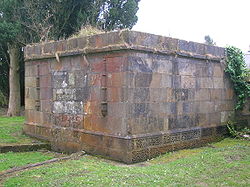
Baillie
A baillie or bailie is a civic officer in the local government of Scotland. The position arose in the burghs, where baillies formerly held a post similar to that of an alderman or magistrate...
- Kyle
Kyle, Ayrshire
Kyle is a former comital district of Scotland which stretched across parts of modern day East Ayrshire and South Ayrshire...
, Carrick
Carrick, Scotland
Carrick is a former comital district of Scotland which today forms part of South Ayrshire.-History:The word Carrick comes from the Gaelic word Carraig, meaning rock or rocky place. Maybole was the historic capital of Carrick. The county was eventually combined into Ayrshire which was divided...
and Cunninghame. The two powerful families residing in Cunninghame - the Cunninghame's and the Montgomeries
Earl of Eglinton
Earl of Eglinton is a title in the Peerage of Scotland.Some authorities spell the title: Earl of Eglintoun In 1859 the thirteenth Earl of Eglinton, Archibald Montgomerie, was also created Earl of Winton in the Peerage of the United Kingdom, which gave him an automatic seat in the House of Lords,...
- had been involved in a dispute over landholdings which came to a head in 1586 when Hugh, 4th the Earl of Eglinton
Earl of Eglinton
Earl of Eglinton is a title in the Peerage of Scotland.Some authorities spell the title: Earl of Eglintoun In 1859 the thirteenth Earl of Eglinton, Archibald Montgomerie, was also created Earl of Winton in the Peerage of the United Kingdom, which gave him an automatic seat in the House of Lords,...
was attacked at the ford on the Annick
River Annick
The Annick Water is the largest tributary of the River Irvine. The river runs from Long Loch, just inside East Renfrewshire, in a generally south-western direction through North Ayrshire and East Ayrshire, to confluence with its parent river at Irvine, North Ayrshire on the west coast of Scotland...
Water (which flows through Stewarton) by 30 or so members of the Cunninghame clan and shot dead by John Cunninghame of Clonbeith. Hugh is said to have been on his way to attend the court of King James VI at Stirling when he decided to stop off at Langshaw House (now Lainshaw house which was for a long time a home for the elderly) to dine with his associates. The lady of the house Lady Montgomery - told several of her Cunninghame associates who lived in the area of the Earl's planned visit. As a response to the killing the Montgomery family declared they would kill every Cunninghame who had been at the river that day and a series of 'tit for tat' killings were carried out between the two families. John Cunninghame of Clonbeith was eventually slain in Hamilton, Scotland, but several of those responsible for the murder fled to Denmark
Denmark
Denmark is a Scandinavian country in Northern Europe. The countries of Denmark and Greenland, as well as the Faroe Islands, constitute the Kingdom of Denmark . It is the southernmost of the Nordic countries, southwest of Sweden and south of Norway, and bordered to the south by Germany. Denmark...
and were eventually granted a pardon by King James upon his marriage to Anne of Denmark
Anne of Denmark
Anne of Denmark was queen consort of Scotland, England, and Ireland as the wife of King James VI and I.The second daughter of King Frederick II of Denmark, Anne married James in 1589 at the age of fourteen and bore him three children who survived infancy, including the future Charles I...
.
Lady Montgomery, who was alleged to have signaled the murderers by placing a white 'napkin' on a window sill, is said to have escaped and lived with her retainer Robert Kerr at Pearce Bank (now High Peacockbank) for several years until the 'hue and cry' died down at which point she returned to the castle and was not molested on the understanding that she did not 'show her face' outside of the grounds. A path known as the 'Weeping or Mourning Path' runs upstream from the Annick (previously Annack or Annock Water) Ford and this is where the Earl's widow is said to have wept as she later followed the trail of blood left behind as his panicked horse took him away from Bridgend. The Earl's body was placed in Lainshaw Castle until arrangements were made to remove it to Eglintoun Castle.
Corsehill and Ravenscraig Castles
The name Ravenscraig or Reuincraig is derived from 'Ruin Crag', i.e. ruined castle. Godfrey de Ross and his family of Corsehill Castle were Lords of Liddesdale in the Borders and later on the CunninghameCunninghame
Cunninghame is a former comital district of Scotland and also a district of the Strathclyde Region from 1975–1996.-Historic Cunninghame:The historic district of Cunninghame was bordered by the districts of Renfrew and Clydesdale to the north and east respectively, by the district of Kyle to the...
s became the holders. Corsehill (also Crosshill) castle is said to have been on the east side of the Corsehill Burn.
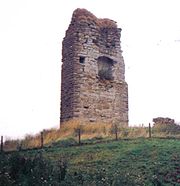
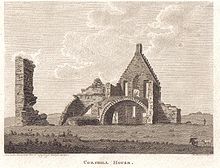
Archibald Adamson in his 'Rambles Round Kilmarnock' of 1875 only records three castles, these being Robertland, Auchenharvie and Corsehill. He makes no mention of the name Ravenscraig, calling the site he visited Corsehill. Aitken only marks Crosshill Castle in 1829 on the west side of the Corsehill Burn. The first OS maps show only the existing castle site, so the new survey has not perpetuate the error.
To sum up, the map in Pont's 'Cuninghame' of 1604-8 shows two buildings, "Reuincraige" and "Corshill", at approximately NS 417 467 and NS 422 465 respectively, and Dobie (1876) comments that the two have often been confused, but that "Reuincraig" stood on the W of the Corsehill Burn and "Corsehill Mansion" on its E. "Reuincraig", he says, was so modernised about 1840 that it was difficult to realise that it had been ruined in 1608, while the ruins of "Corsehill" were removed about the beginning of the 19th century and only foundations could be traced when he wrote. He also thought that "Reuincraig" (i.e. Ruin Craig) was not an original name. If Dobie is correct, the ruins published as "Corsehill Castle" on the OS 6", must be those of "Reuincraig", both because they are standing remains, and because they are on the W bank of the burn. Macgibbon and Ross, describing "Corsehill Castle" at the end of the 19th century as a very ruinous mansion, evidently of late date and apparently of the L-plan, and ascribe it to the period 1542-1700, must be referring to "Reuincraig". Grose, in 1791, published an illustration of "Corshill House", but does not give it a close siting. As, however, he mentions that "at a small distance from this ruin are some small remains of a more ancient building belonging to the same family", he is also probably referring to "Reuincraig", the "small remains" being those of "Corsehill". (Grose 1791); (MacGibbon) and (Ross 1889).
General Roy's Military Survey of Scotland (1745 - 55) marks 'Ravenscraig' as 'Old Corsehill' and also marks the 'new' Corsehill on the other side of the burn, thereby apparently confirming that they both had the same name and one replaced the other, although only 'Old Corsehill' is still in anyway visible, just the foundations of 'new' Coresehill being apparent in 2007. The same map shows buildings named 'Temple' in the area of 'Templehouse'.
The Stewarton Flower
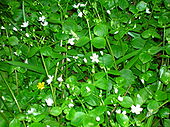
Claytonia sibirica
Claytonia sibirica is a flowering plant in the family Portulacaceae, native to Siberia and western North America. A synonym is Montia sibirica...
(Claytonia sibirica) is found in damp areas. This plant was introduced from North America in Victorian times, quite possibly at the Robertland Estate.
In 1915 it was stated to have been in the area for over 60 years and was abundant on the Corsehill Burn
River Irvine
The River Irvine is a river flowing through southwest Scotland, with its watershed on the Lanarkshire border of Ayrshire at an altitude of above sea-level, near Drumclog, and SW by W of Strathaven...
below Robertland in 1915. As far away as Dalgarven Mill
Dalgarven Mill
Dalgarven Mill is near Kilwinning, in the Garnock Valley, North Ayrshire, Scotland and it is home to the Museum of Ayrshire Country Life and Costume. The watermill has been completely restored over a number of years and is run by the independent Dalgarven Mill Trust.The village of Dalgarven was...
the white flowered variety still dominates. The plant is very adept at reproducing by asexual plantlets and this maintains the white gene pool around Stewarton. The pink variety has not been able to predominate here, unlike almost everywhere else in the lowlands of Scotland, England and Wales. Claytonia sibirica is a seriously destructive alien invader which should not be transplanted to other sites.
The Conventicles and the Highland host
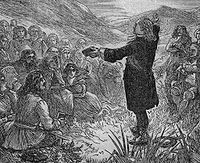
Covenanter
The Covenanters were a Scottish Presbyterian movement that played an important part in the history of Scotland, and to a lesser extent in that of England and Ireland, during the 17th century...
s holding 'Conventicles', King Charles II moved highland troops, the 'Highland Host' into the west-land of Ayrshire. "They took free quarters; they robbed people on the high road; they knocked down and wounded those who complained; they stole, and wantonly destroyed, cattle; they subjected people poo to the torture of fire to discover to them where their money was hidden; they threatened to burn down houses if their demands were not at once complied with; besides free quarters they demanded money every day; they compelled even poor families to buy brandy and tobacco for them; they cut and wounded people from sheer devilment." The cost of all this amounted to £6062 12s 8d in Stewarton parish.
The 1767 Toll Road to Irvine
Thomas Oliver was titled "roadmaker in Stewarton", being employed by the Kilmarnock to Irvine road committee. He worked with the specifications of a road twenty four feet wide, fourteen inches thick in the middle to ten inches in the sides, the understratum to be made of stones not exceeding six pounds tron weight and six inches thick, etc. Very precise requirements which would cost seven shilling per fall from Annick Bridge to Gareer Burn, but ten shillings per fall from Gareer Burn to Corsehouse bridge (Crosshouse) because of the lack of suitable materials locally.Railways
The station was opened in 1871 by the Glasgow, Barrhead and Kilmarnock Joint Railway. The station closed in 1966, reopening in 1967. In 2009-2010 the line was partly re-doubled and the train frequency increased to two trains an hour in each direction. The station was rebuilt and a second platform brought into use.Local events
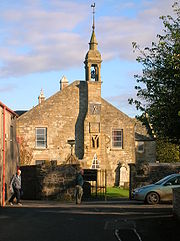
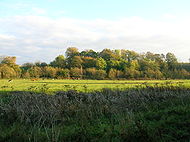
The Cadgers’ Fair was an annual event unique to Stewarton in the 18th Century. "Our annual fair took place on Monday last. In the morning there was a large turnout of cattle. . . . Our Cadgers’ procession was a slight improvement on some former occasions, and headed by a brass band they marched through the town, thence to a field on the farm of Robertland where the races took place". Horses were traded and much of the 'action' took place in the Avenue Square.
Each year Stewarton holds a small orange parade to mark the anniversary of The Battle of the Boyne. The parade is made up of Stewarton's Annick Crown Loyal Defenders (LOL 253), Kilmarnock Purple Heroes (LOL 289) and the Spirit of Stewarton Flute Band
Views on the Lainshaw & Annick Cycle and pedestrian paths in 2007 & 2008
The Stewarton Woodland Action Trust (SWAT) is building an extensive network of joint pedestrian, cycle and equestrian paths to open up access to the countryside in the Stewarton area. One path runs through the lands of the old Lainshaw EstateLands of Lainshaw
The Lands of Lainshaw lie in Strathannick and were part of the Lordship of Stewarton. Lainshaw House is a Grade B listed mansion lying in a prominent position above the Annick Water and its holm in the Parish of Stewarton, Scotland. A much older Lainshaw Castle tower is contained within the several...
, largely following the old carriage rides.
In recent years, Stewarton traders and residents have created and developed a new annual event. The "Stewarton yuletide festival" usually takes place in mid-December and sees many of the town's shops and local businesses extending their opening hours, to allow "late shopping." In addition, entertainment and activities take place in the town's Avenue Square and Main Street. The event embraces the neighbouring towns of Dunlop, Fenwick and Kilmaurs as well.
Micro history of the area
The War Memorial used to stand outside the front of the library in the avenue square and was moved to provide a more suitable setting near Standalane house above Lainshaw primary school.Dunlop cheese
Dunlop cheese
Dunlop is a mild cheese or 'sweet-milk cheese' from Dunlop in East Ayrshire, Scotland. It resembles a soft Cheddar cheese in texture. It fell out of popularity some time after the end of the Second World War, however it has now appreciated for its value in various recipes and for eating on its own...
was made in Stewarton as well as many other Ayrshire localities, such as Beith
Beith
Beith is a small town situated in the Garnock Valley in North Ayrshire, Scotland approximately 20-miles south-west of Glasgow. The town is situated on the crest of a hill and was known originally as the "Hill o' Beith" after its Court Hill.-History:-Name:Beith's name is thought to emanate from...
.
Rabbie Burns's uncle is known to have helped guard the Stewarton Laigh Church graveyard against the activities of body snatchers.
The ground of Stewarton's cricket club was located between Lochridge and Ward Park house.
On 27 January 2009, a BP tanker train carrying liquid fuels (diesel and heating oil) from Mossend to Riccarton was derailed at the bridge over the Stewarton to Kilmaurs road at Peacockbank Farm. Several wagons subsequently caught fire. The Lochrig Burn was badly polluted, however the Annick Water escaped major contamination.
See also
- Barony and Castle of Corsehill
- River IrvineRiver IrvineThe River Irvine is a river flowing through southwest Scotland, with its watershed on the Lanarkshire border of Ayrshire at an altitude of above sea-level, near Drumclog, and SW by W of Strathaven...
The Annick Water and other tributaries. - Lands of LainshawLands of LainshawThe Lands of Lainshaw lie in Strathannick and were part of the Lordship of Stewarton. Lainshaw House is a Grade B listed mansion lying in a prominent position above the Annick Water and its holm in the Parish of Stewarton, Scotland. A much older Lainshaw Castle tower is contained within the several...
- LambroughtonLambroughtonLambroughton is a village in the old Barony of Kilmaurs, North Ayrshire, Scotland. This is a rural area famous for its milk and cheese production and the Ayrshire or Dunlop breed of cattle.-Origins of the name:...
- ChapeltounChapeltounChapeltoun is an estate on the banks of the Annick Water in East Ayrshire, Scotland. This is a rural area famous for its milk and cheese production and the Ayrshire or Dunlop breed of cattle.-Templeton and the Knights Templar:...
- Corsehill
- Castle and Barony of RobertlandCastle and Barony of RobertlandThe Castle and Barony of Robertland is located near Stewarton, off the B769 road, in the old district of Cunninghame, Parish of Stewarton, and now part of East Ayrshire, Scotland.-Robertland castle and barony:...
- List of places in East Ayrshire
- Stewarton HiveStewarton HiveThe Stewarton hive is a type of historical bee hive. Extra boxes below allowed expansion of the brood, and thus strongly inhibited swarming and any tendency for the queen to enter the honey boxes, while expansion with extra honey boxes above the brood area gave ample space for the bees to create...
- Stewarton railway stationStewarton railway stationStewarton railway station is a railway station in the town of Stewarton, East Ayrshire, Scotland. The station is managed by First ScotRail and is on the Glasgow South Western Line.- History :...
External links
- RCAHMS Canmore archaeology site
- http://www.lawrie.freewire.co.uk/MAPS/stewartonmap.gif
- http://www.stewarton.org/History/SLAUGHTER_AT_STEWARTON.htm
- http://www.stewarton.org/History/The%20Bonnet%20Toun%20-%20Alastair%20Barclay/Cover.htm
- Maps at the National Library of Scotland
- 1860 OS Maps
- General Roy's Military Survey map of Scotland.
- A Researcher's Guide to Local History terminology
- http://www.stewarton.com

